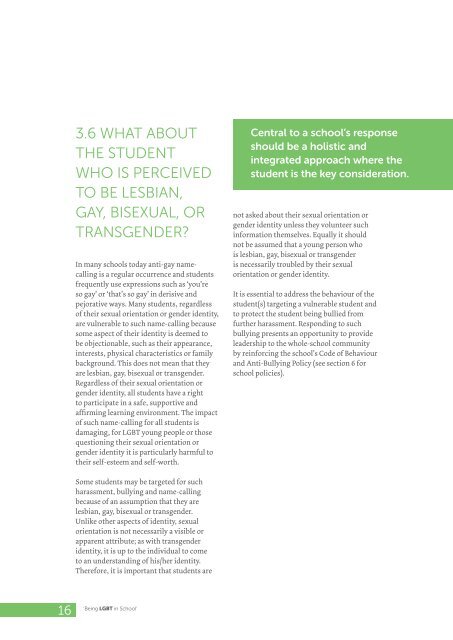‘BEING LGBT IN SCHOOL’
GLEN__Being_LGBT_in_School_10_Feb_2016_Web_3
GLEN__Being_LGBT_in_School_10_Feb_2016_Web_3
You also want an ePaper? Increase the reach of your titles
YUMPU automatically turns print PDFs into web optimized ePapers that Google loves.
3.6 WHAT ABOUT<br />
THE STUDENT<br />
WHO IS PERCEIVED<br />
TO BE LESBIAN,<br />
GAY, BISEXUAL, OR<br />
TRANSGENDER?<br />
In many schools today anti-gay namecalling<br />
is a regular occurrence and students<br />
frequently use expressions such as ‘you’re<br />
so gay’ or ‘that’s so gay’ in derisive and<br />
pejorative ways. Many students, regardless<br />
of their sexual orientation or gender identity,<br />
are vulnerable to such name-calling because<br />
some aspect of their identity is deemed to<br />
be objectionable, such as their appearance,<br />
interests, physical characteristics or family<br />
background. This does not mean that they<br />
are lesbian, gay, bisexual or transgender.<br />
Regardless of their sexual orientation or<br />
gender identity, all students have a right<br />
to participate in a safe, supportive and<br />
affirming learning environment. The impact<br />
of such name-calling for all students is<br />
damaging, for <strong>LGBT</strong> young people or those<br />
questioning their sexual orientation or<br />
gender identity it is particularly harmful to<br />
their self-esteem and self-worth.<br />
Central to a school’s response<br />
should be a holistic and<br />
integrated approach where the<br />
student is the key consideration.<br />
not asked about their sexual orientation or<br />
gender identity unless they volunteer such<br />
information themselves. Equally it should<br />
not be assumed that a young person who<br />
is lesbian, gay, bisexual or transgender<br />
is necessarily troubled by their sexual<br />
orientation or gender identity.<br />
It is essential to address the behaviour of the<br />
student(s) targeting a vulnerable student and<br />
to protect the student being bullied from<br />
further harassment. Responding to such<br />
bullying presents an opportunity to provide<br />
leadership to the whole-school community<br />
by reinforcing the school’s Code of Behaviour<br />
and Anti-Bullying Policy (see section 6 for<br />
school policies).<br />
Some students may be targeted for such<br />
harassment, bullying and name-calling<br />
because of an assumption that they are<br />
lesbian, gay, bisexual or transgender.<br />
Unlike other aspects of identity, sexual<br />
orientation is not necessarily a visible or<br />
apparent attribute; as with transgender<br />
identity, it is up to the individual to come<br />
to an understanding of his/her identity.<br />
Therefore, it is important that students are<br />
16<br />
‘Being <strong>LGBT</strong> in School’


